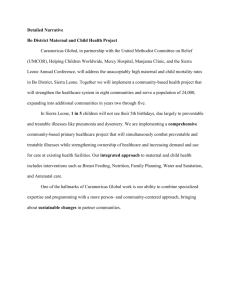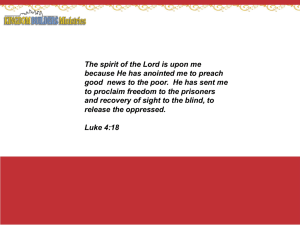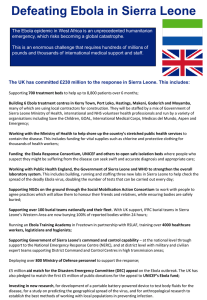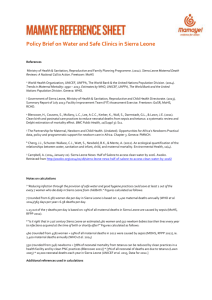Sierra Leone`s Contribution - Great War in Africa Association
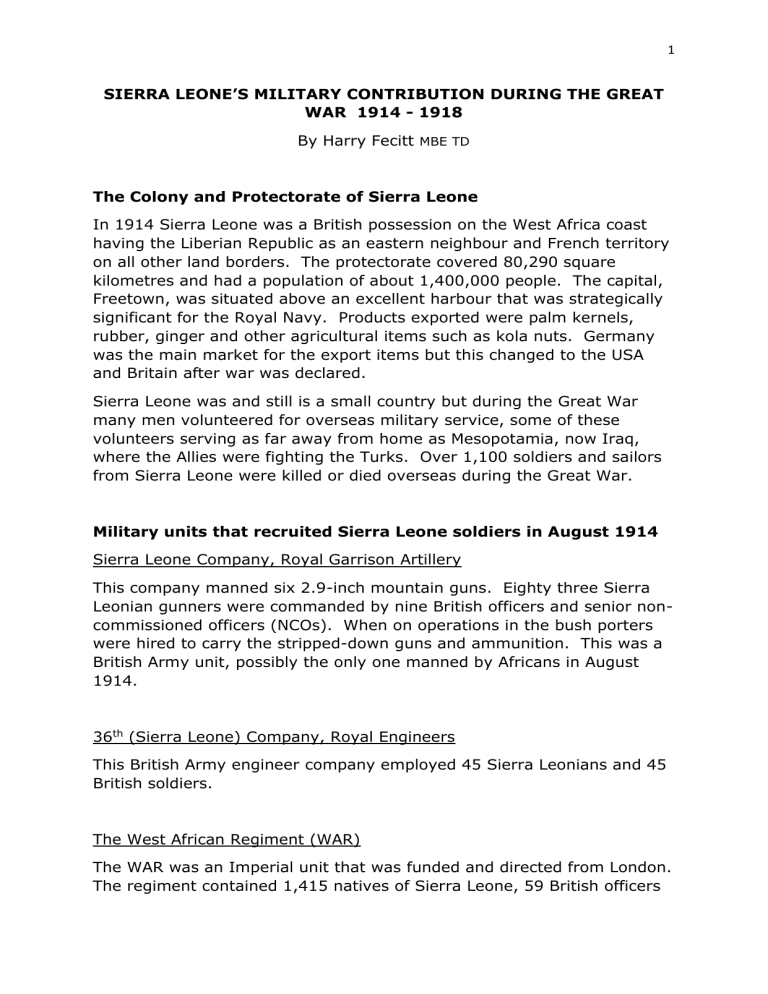
1
SIERRA LEONE’S MILITARY CONTRIBUTION DURING THE GREAT
WAR 1914 - 1918
By Harry Fecitt MBE TD
The Colony and Protectorate of Sierra Leone
In 1914 Sierra Leone was a British possession on the West Africa coast having the Liberian Republic as an eastern neighbour and French territory on all other land borders. The protectorate covered 80,290 square kilometres and had a population of about 1,400,000 people. The capital,
Freetown, was situated above an excellent harbour that was strategically significant for the Royal Navy. Products exported were palm kernels, rubber, ginger and other agricultural items such as kola nuts. Germany was the main market for the export items but this changed to the USA and Britain after war was declared.
Sierra Leone was and still is a small country but during the Great War many men volunteered for overseas military service, some of these volunteers serving as far away from home as Mesopotamia, now Iraq, where the Allies were fighting the Turks. Over 1,100 soldiers and sailors from Sierra Leone were killed or died overseas during the Great War.
Military units that recruited Sierra Leone soldiers in August 1914
Sierra Leone Company, Royal Garrison Artillery
This company manned six 2.9-inch mountain guns. Eighty three Sierra
Leonian gunners were commanded by nine British officers and senior noncommissioned officers (NCOs). When on operations in the bush porters were hired to carry the stripped-down guns and ammunition. This was a
British Army unit, possibly the only one manned by Africans in August
1914.
36 th (Sierra Leone) Company, Royal Engineers
This British Army engineer company employed 45 Sierra Leonians and 45
British soldiers.
The West African Regiment (WAR)
The WAR was an Imperial unit that was funded and directed from London.
The regiment contained 1,415 natives of Sierra Leone, 59 British officers
2 and 25 British NCOs. The regiment was organised into 12 rifle companies that were located at Freetown and three other points in the Protectorate.
The Sierra Leone Battalion of the West African Frontier Force
The West African Frontier Force (WAFF) was a local formation that raised military units in Gambia, Gold Coast (now Ghana) and Nigeria as well as in Sierra Leone. It was directed by the British Colonial Office in London but was paid for by the participating colonies and protectorates; local
British Governors of the four colonies could use their WAFF units to support the local police during disturbances. The Sierra Leone Battalion of the WAFF consisted of 640 Africans from Sierra Leone, 28 British officers and one British NCO.
Other British Army units in Sierra Leone in August 1914
50 th Company, Royal Garrison Artillery
This company was a British Army unit manned by Europeans that had a coastal defence role. Its guns were sited to protect Freetown Harbour.
The 1 st Battalion The West India Regiment (WIR)
The West India Regiment was a British Army Imperial Service unit recruited in the West Indies, mainly from Jamaica; it was directed from
London. Battalions of the WIR had garrisoned British possessions in West
Africa for over 20 years. Service in West Africa was very unhealthy for white soldiers and it was found that West Indies men had more resistance to tropical ailments. The 1 st Battalion WIR rotated with the 2 nd Battalion
WIR in serving in Sierra Leone. The battalion not in West Africa was based in Jamaica.
British Army Detachments
In and around Freetown were British Army detachments from the Royal
Army Medical Corps, the Army Service Corps and the Army Ordnance
Corps plus specialist individuals from other Corps.
As well as the Army units so far mentioned the Royal Navy maintained a base at Freetown that was an important coaling station, and employed
Sierra Leonians in a variety of jobs.
3
The first operation – the conquest of German Togoland
On 17 th August 1914 two companies of the Sierra Leone Battalion WAFF were ordered to move to Togoland to assist in the conquest of that
German territory. The two companies arrived the day after Togoland had surrendered, so they were diverted to take part in the invasion of German
Kamerun.
The second operation – the conquest of German Kamerun
A joint French and British army and naval force invaded German Kamerun from 6 th August onwards and the campaign lasted until February 1916 when the last German troops in the north of Kamerun surrendered; many
German troops in the south escaped into neutral Spanish Rio Muni, now
Equatorial Guinea, and were interned by the Spanish authorities.
During the fighting in Kamerun the Sierra Leone Company, Royal Garrison
Artillery, took part as did engineers from 36 th Company, Royal Engineers.
It was soon realised that the gun crews needed well-trained porters to carry the guns and ammunition and porters were enlisted and trained specifically for those tasks. The engineers bridged rivers and improved roads in the interior of Kamerun so that British artillery could use them.
Six companies and two machine guns of the West African Regiment were deployed on offensive operations in Kamerun, as was the whole of the
Sierra Leone Battalion WAFF.
German Kamerun was a physically exhausting theatre to operate in and all the soldiers there had to be aware of dangers in the dense forests such as jigger fleas, that squirmed inside men’s toenails causing ulcers and sores.
The third operation – the conquest of German East Africa
After the Kamerun campaign ended in February 1916 WAFF units from
Nigeria, Gold Coast and Gambia were prepared, trained and then despatched around Africa to German East Africa. The Sierra Leonian contribution to this campaign was to provide 4,500 porters organised into companies of 500 men each. These porters accompanied the Gold Coast and Nigerian infantry and mountain artillery units, and they were the strongest and most reliable porters in East Africa. On some occasions when fighting developed in thick bush the Sierra Leonian porters fought with their machetes against the German Askari attacking them with rifles
4 and bayonets. These porters worked in Portuguese East Africa, now
Mozambique, during the 1918 campaign there until the Armistice was recognised by the Germans.
The fourth operation – river transport duties in Mesopotamia
Indian troops did most of the fighting in the British campaign against the
Turks in Mesopotamia, now Iraq. Of vital importance in Mesopotamia were the Rivers Euphrates and Tigris, as the absence of good roads and railway lines meant that the two rivers were used to move troops and supplies. A large Inland Water Transport Service was established by the
British who needed men who could manage small boats and establish and man riverside docks. Nearly 1,000 boatmen and dock workers went from
West Africa including from Sierra Leone. The men crewed river steamers and monitors, were trained to drive motor boats and constructed and manned docks.
Whilst travelling to Mesopotamia the ship carrying the Sierra Leonian river transport men stopped at Dar Es Salaam in German East Africa. Some of the men were tasked temporarily with unloading cargo and they performed so well that the port authorities requested that 100 Sierra
Leonians stay behind at Dar Es Salaam to run the docks; this was agreed to.
Sadly 29 men died of cholera when in Karachi on their way Mesopotamia.
A further 30 or more died of bronchitis and pneumonia in Mesopotamia.
All the West Africans were repatriated in July 1918 but on their way home they were landed at Capetown for three months whilst a severe influenza epidemic moved across Africa. The men provided a useful labour force to assist in the medical emergency measures, most of them being unaffected by the influenza. In January 1919 the men arrived back home, no doubt with interesting and unusual tales to tell to their friends and families.
Support for French operations against dissidents at Agadez
In 1916 a revolt of the Southern Tuareg tribes broke out in French territory in what is today northern Niger. Agadez was besieged for three months until a French force relieved it. In January 1917 four companies and four machine guns of the West African Regiment moved into northern
Nigeria to support France. These British troops did not join in the fighting but were held in reserve at Zaria for two months before returning to
Sierra Leone.
5
Providing garrisons for other territories.
From 1917 to 1918 one company of the West African Regiment garrisoned captured German Togoland. Another WAR company garrisoned Gambia as the only WAFF unit there, The Gambia Company, WAFF, was deployed in East Africa.
AWARDS RECEIVED BY SIERRA LEONIAN SOLDIERS DURING THE
GREAT WAR GERMAN KAMERUN CAMPAIGN
West African Frontier Force Distinguished Conduct Medal
Privates No. 3367 Monde Geraia and No. 3194 Santiggi Karnu (same citation) - . . . this man made gallant efforts, under a heavy and accurate maxim gun fire, to assist Lieutenant Dawes to move Lieutenant Parker to a place of safety after that officer had been wounded.
No. 2900 Private Samba Kaiter - . . . an officer who was conducting a retirement under hostile machine gun fire fell exhausted, owing to recent illness, about 30 yards from cover. Private Samba Kaiter, under heavy rifle and machine gun fire, ran out from cover and brought him in.
No. 2999 Lance Corporal Sorie Karnu – citation not traced.
All these four men served in the Sierra Leone Battalion of the West
African Frontier Force.
Conclusion
Although only a small country, during the Great War Sierra Leone provided thousands of men, all volunteers, who were trained and used in a number of different military occupations in theatres as far distant as
Mesopotamia. Over 1,100 men did not return and were buried in foreign territories or at sea, but their names are recorded on the Freetown
Memorial that is maintained by the Commonwealth War Graves
Commission. The Sierra Leonians proved to be very adaptable and useful soldiers and sailors, and the now independent nation of Sierra
Leone can be very proud of its men who fought in the Great War.
SOURCES:
The Empire at War by Charles Prestwood Lucas (Oxford University Press
1921).
Operations of Sierra Leone Troops in the Great War 1914-1918. British
National Archives file reference: CAB 45/113.
6



